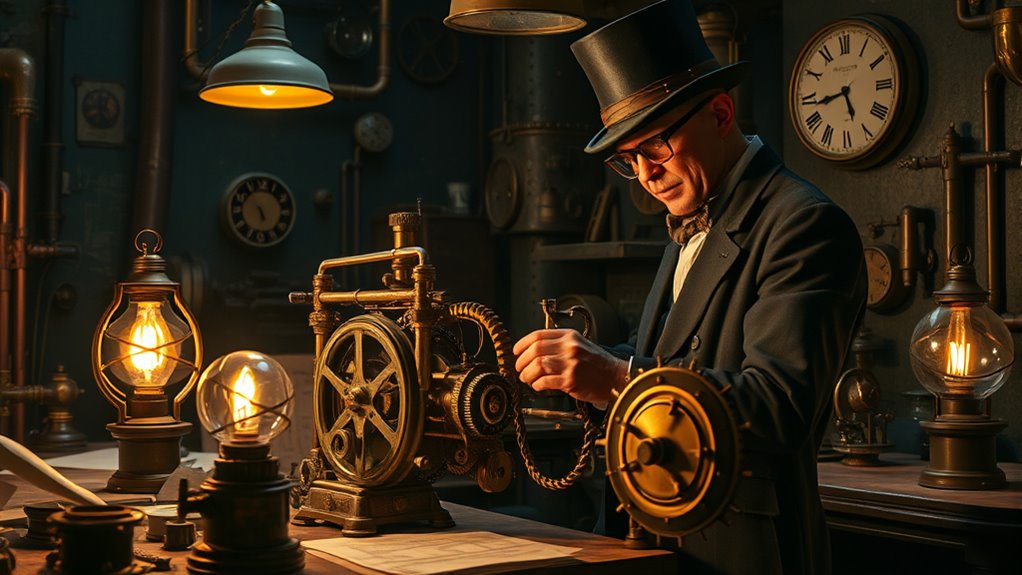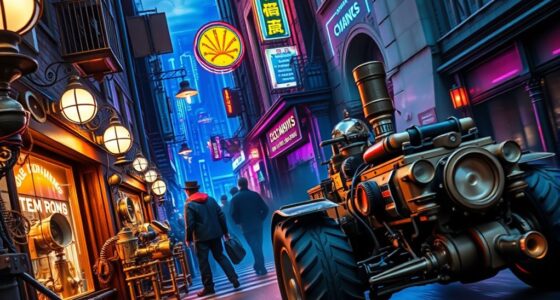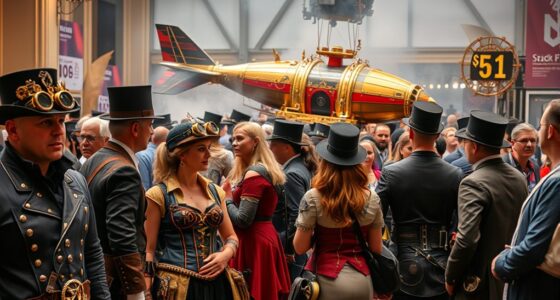Steampunk began when K.W. Jeter coined the term in 1987, merging Victorian aesthetics with imaginative technology. Influenced by classic writers like H.G. Wells and Jules Verne, this genre emerged from the Industrial Revolution‘s societal changes. It captured a blend of whimsy and innovation, showcasing characters like airship pirates and eccentric inventors. Steampunk‘s distinct style and themes of progress and caution resonate in today’s culture. There’s much more to uncover about this fascinating movement.
Key Takeaways
- K.W. Jeter coined the term “steampunk” in 1987 to describe a blend of Victorian imagery and advanced technology in literature.
- The genre was inspired by Victorian literature, architecture, and technological innovations, notably influenced by authors like H.G. Wells and Jules Verne.
- Steampunk emerged as a reaction to the rapid urbanization and technological advancements of the Industrial Revolution, reflecting societal changes and challenges.
- Foundational works like *The Difference Engine* and *Infernal Devices* established key themes and character archetypes that define steampunk narratives.
- The aesthetic of steampunk combines retrofuturism with Victorian elements, emphasizing creativity, sustainability, and the consequences of technological progress.
The Coining of the Term “Steampunk”
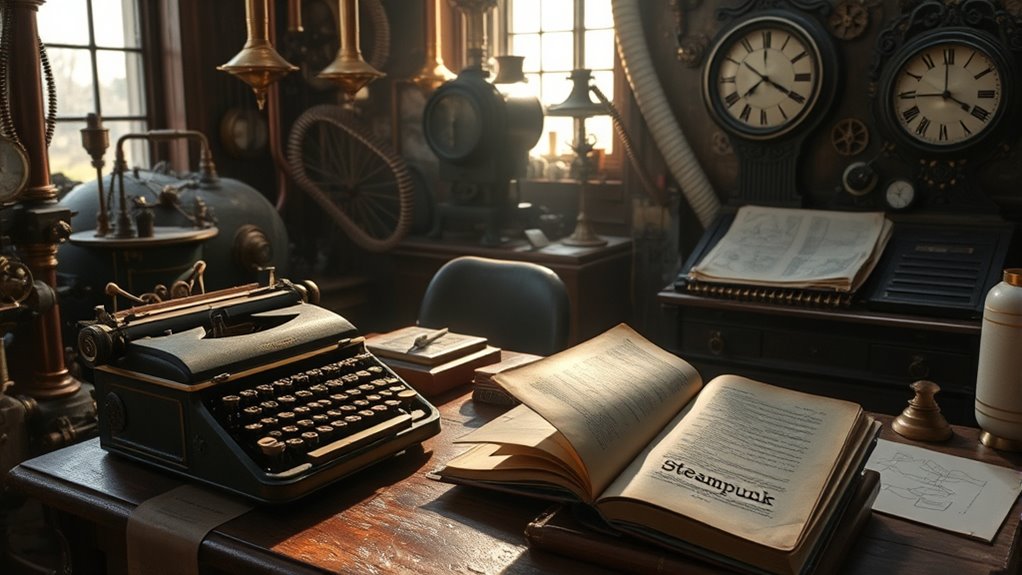
When K.W. Jeter coined the term “steampunk” in 1987, he aimed to capture a unique blend of Victorian imagery and advanced technology.
In a letter to *Locus* magazine, he sought a collective name for the works of himself and fellow authors Tim Powers and James Blaylock. Inspired by the popularity of “cyberpunk,” Jeter cleverly adapted the name, creating a genre that would soon enchant readers. The emergence of steampunk coincided with a growing interest in alternative assets that appeal to creative minds and those seeking unique narratives. This interest in comparative advantage reflects the innovative spirit that steampunk embodies. Additionally, the concept of diversification resonates with steampunk enthusiasts, as they often explore various creative expressions within the genre. The genre’s appeal is further enhanced by the use of AI technology that aids in developing intricate narratives and immersive worlds.
Steampunk emerged as a playful reaction to its predecessor, focusing instead on steam-powered machinery and a whimsical historical context. Jeter’s initiative sparked a movement, leading to the genre’s rapid evolution and recognition among fans of science fiction and fantasy.
Steampunk playfully reimagines history through steam technology, igniting a vibrant movement in science fiction and fantasy.
This term laid the foundation for a vibrant literary and cultural phenomenon.
Inspirations From the Victorian Era

Steampunk draws heavily from the rich tapestry of the Victorian era, weaving together its literature, architecture, fashion, and technological innovations. Influential authors like H.G. Wells and Jules Verne crafted stories filled with futuristic visions, themes of social change, and moral dilemmas that resonate in Steampunk narratives today. Steampunk’s unique style even fuses historical influences with modern sensibilities, creating a whimsical aesthetic. You’ll notice that Victorian architecture inspires grand structures and intricate details, often paired with industrial elements. Additionally, the era’s emphasis on sustainable innovation led to creative solutions that resonate with today’s eco-conscious values. Notably, the impact of industrialization during this time spurred advancements that would later inspire the imaginative machinery found in Steampunk creations. Furthermore, the Victorian fascination with exploration and discovery contributed significantly to the adventurous spirit that characterizes Steampunk. This spirit is mirrored in the incorporation of natural elements that promote tranquility within Steampunk-inspired spaces. In fashion, corsets and petticoats take center stage, alongside accessories like top hats and gloves that add flair. Ultimately, the Victorian era’s creativity and ingenuity shape the Steampunk world, inviting you to explore its wonders.
The Impact of the Industrial Revolution
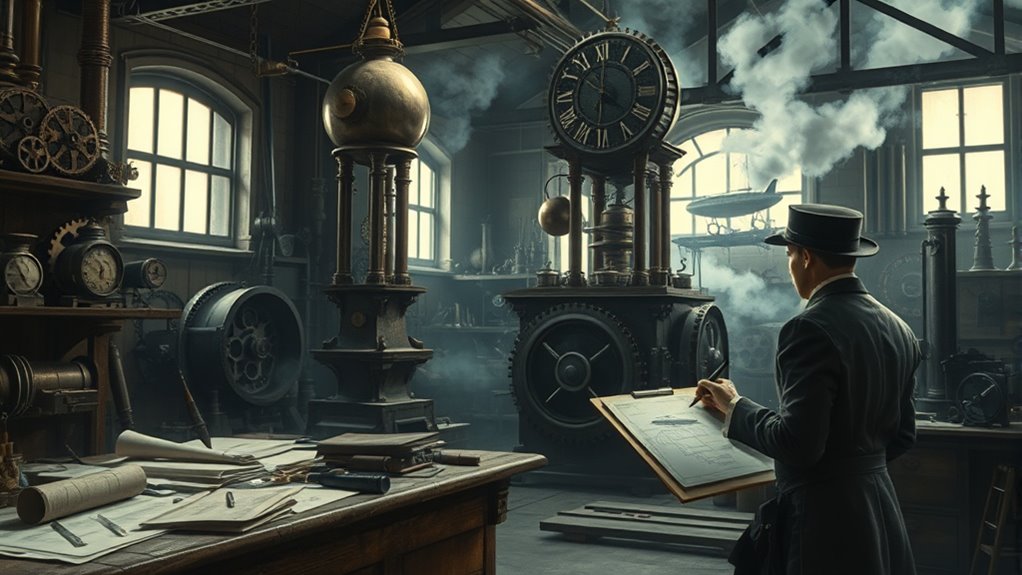
As the Industrial Revolution swept through society, it reshaped every facet of daily life, leaving a profound impact on culture and economy.
You’d witness people flocking to cities, driven by job opportunities, leading to rapid urbanization. However, this shift brought challenges like overcrowding, poor sanitation, and disease. Poorly constructed tenements contributed to the spread of illness, exacerbating the struggles faced by urban dwellers.
The emergence of a middle class changed social dynamics, while technological advancements, such as the steam engine and innovative machinery, revolutionized production.
Transportation improvements like railroads facilitated commerce, and communication inventions like the telegraph sped up business operations.
Despite the benefits, harsh working conditions sparked labor movements that fought for rights and reform.
This tumultuous period laid the groundwork for the steampunk aesthetic, blending the old with the new in imaginative ways.
Literary Precursors of Steampunk
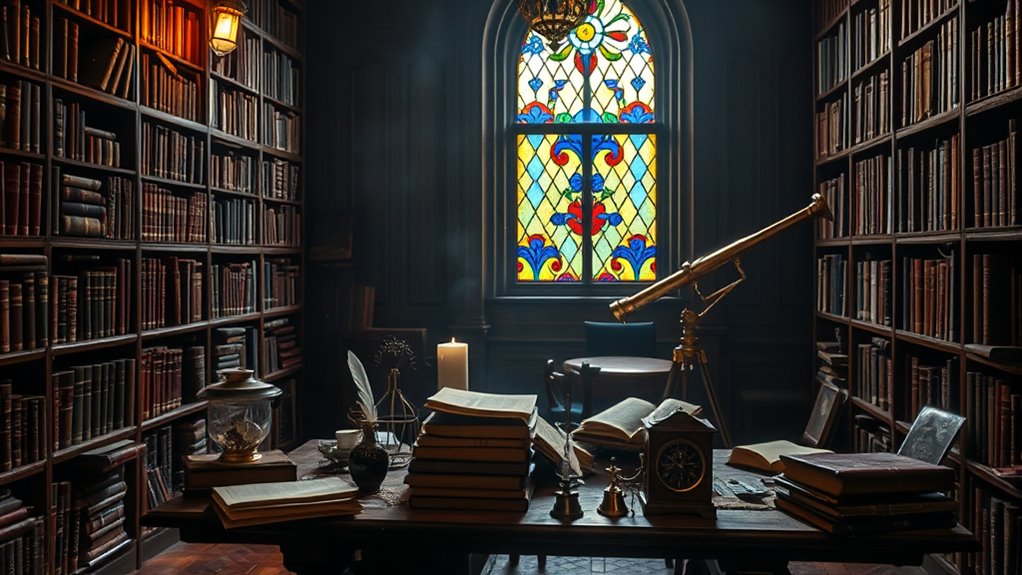
The foundations of Steampunk can be traced back to the imaginative works of early science fiction writers who envisioned a world where advanced technology coexists with historical settings.
Authors like Jules Verne and H.G. Wells created narratives filled with futuristic inventions and themes of exploration. Verne’s *20,000 Leagues Under the Sea* and Wells’ *The Time Machine* exemplify these ideas, merging adventure with speculative technology. Meanwhile, Mary Shelley’s *Frankenstein* introduced the concept of the “mad scientist,” influencing Steampunk’s exploration of innovation. These literary precursors shaped the genre’s aesthetic, incorporating Victorian elements and social commentary. They set the stage for a rich tapestry of stories that blend the fantastical and the historical, inspiring later Steampunk literature and subcultures. This blend of Victorian fantasies continues to captivate audiences and influence various forms of art and entertainment today, much like how emotional dysregulation affects interpersonal dynamics in modern narratives. Furthermore, the rise of generative AI in media and entertainment has the potential to redefine storytelling within the Steampunk genre, enabling new creative possibilities. Additionally, the influence of predictive modeling can enhance the understanding of audience preferences, allowing creators to tailor their narratives more effectively. The spirit of adventure and discovery, akin to that of great explorers, resonates deeply within the Steampunk genre, inviting readers to embark on their own imaginative journeys.
Key Works in Steampunk Literature
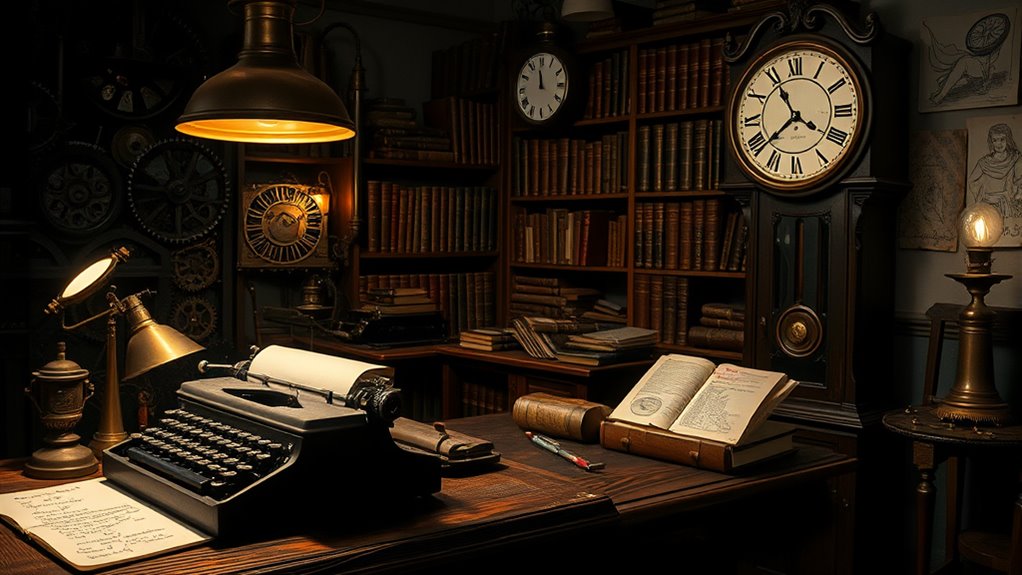
Key works in Steampunk literature showcase a unique blend of historical settings, imaginative technology, and adventurous storytelling.
You’ll find foundational novels like The Difference Engine by Bruce Sterling and William Gibson, which shaped the genre, alongside Infernal Devices by K.W. Jeter, who popularized the term itself. Proper diet for the characters often reflects the Victorian era’s fascination with innovation and industry. The emphasis on high-quality equipment in these narratives often mirrors the meticulous craftsmanship found in steampunk culture.
Tim Powers’ The Anubis Gates creatively merges history with fantasy, while Michael Moorcock’s The Warlord of the Air sets the stage for airship adventures.
Don’t miss The Golden Compass by Philip Pullman, where steampunk meets rich Victorian-like fantasy. It is particularly notable for its compelling child protagonist who navigates a world filled with airships and other steampunk elements.
As you explore, you’ll encounter diverse narratives, from The Scar by China Miéville to The Alchemy of Stone by Ekaterina Sedia, each adding depth to the ever-evolving steampunk landscape.
Character Archetypes in Steampunk Narratives

While exploring steampunk narratives, you’ll encounter a variety of character archetypes that bring the genre to life.
Airship pirates embody rebellion, raiding and skirmishing across the skies. Adventurers and explorers seek new discoveries, often facing perilous missions. Aristocrats flaunt wealth and style, while mechanics and inventors showcase their ingenuity through complex devices that often reflect smart shopping techniques. These inventors may also draw inspiration from breakthrough technologies that revolutionize their creations. The innovative designs of these devices often resonate with the principles of aesthetic enhancements found in modern home decor. In the world of steampunk, the use of solar energy is often depicted as a vital resource powering fantastical inventions.
Eccentric scientists add an analytical flair, bridging fantasy and technology, often driven by a passion for steampunk innovations. You’ll also find mad scientists and charming dandy figures, each with their own moral ambiguities. Commoners and navvies play essential roles, grounding the stories in social realities.
Finally, aviators add a gallant touch, piloting fantastical vehicles. These archetypes reflect themes of rebellion, exploration, and moral conflict, enriching the steampunk experience.
The Aesthetic of Steampunk Culture
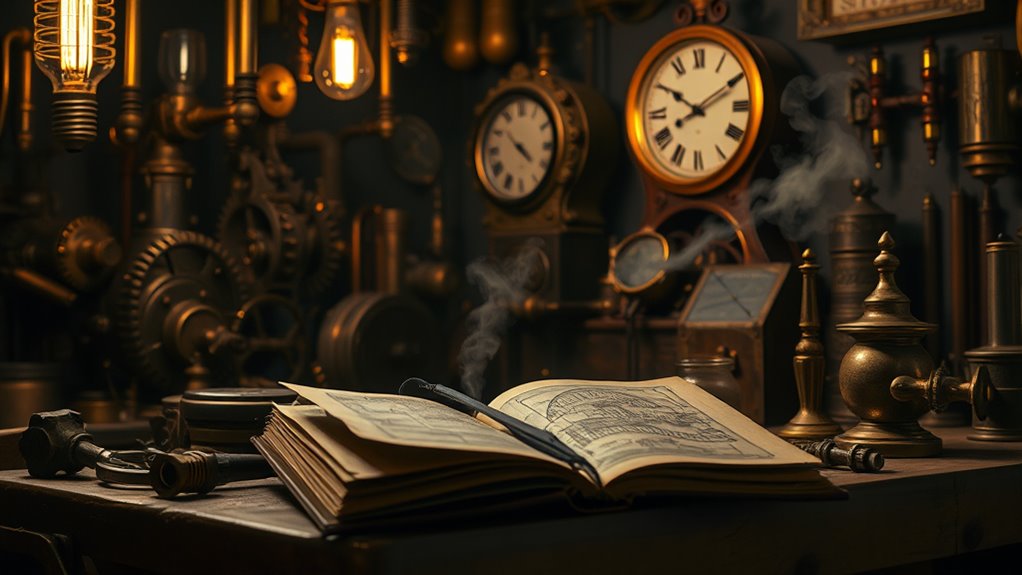
Steampunk culture captivates with its unique blend of historical and futuristic aesthetics, drawing you into a world where Victorian elegance meets industrial innovation.
You’ll notice retrofuturism shines through, with visible gears, pipes, and steam valves that echo the industrial roots of the genre.
Fashion often features 19th-century clothing—think top hats, corsets, and waistcoats—paired with accessories like goggles and pocket watches, all adorned with brass and leather. This aesthetic is further enhanced by the use of polished wood and brass in both fashion and design, solidifying the retro element of steampunk. Butter’s malleability and vibrant color can inspire intricate artistic designs that resonate with the steampunk ethos of blending the mechanical with the artistic. The incorporation of natural materials also reflects a growing trend towards sustainability within the steampunk community. Additionally, the emphasis on creativity and self-expression within steampunk art mirrors the principles of music therapy, fostering a deeper connection to one’s emotions.
The art you encounter frequently showcases handmade objects that weave together nature and machinery, creating a distinct visual narrative.
Steampunk in Modern Pop Culture

As the allure of steampunk continues to grow, it finds a prominent place in modern pop culture, capturing the imagination of audiences across various mediums. Iconic films like *The City of Lost Children* and *Wild Wild West* showcase its cinematic influence, while series such as *Doctor Who* and *Fullmetal Alchemist* weave steampunk elements into their narratives. This aesthetic appeals visually, often critiquing modern technology and societal progress. The intricate designs and craftsmanship seen in steampunk fashion echo the principles of haute couture, emphasizing the artistry involved in garment creation. Additionally, the vibrant world of Bollywood films has begun to incorporate steampunk elements, further expanding its cultural reach. The genre has also influenced design trends in home appliances, blending vintage styles with modern functionality.
In music, genres like folk rock and industrial dance thrive on steampunk themes, with artists embracing the style in music videos and live performances. The genre invites the imagination of a future that never was, envisioning different technological paths and outcomes. Powerful words from steampunk narratives often inspire creativity and innovation, encouraging fans to explore their artistic expression. Fashion also flourishes, blending Victorian elegance with industrial flair, encouraging DIY creativity.
The Role of Steam-Powered Technology
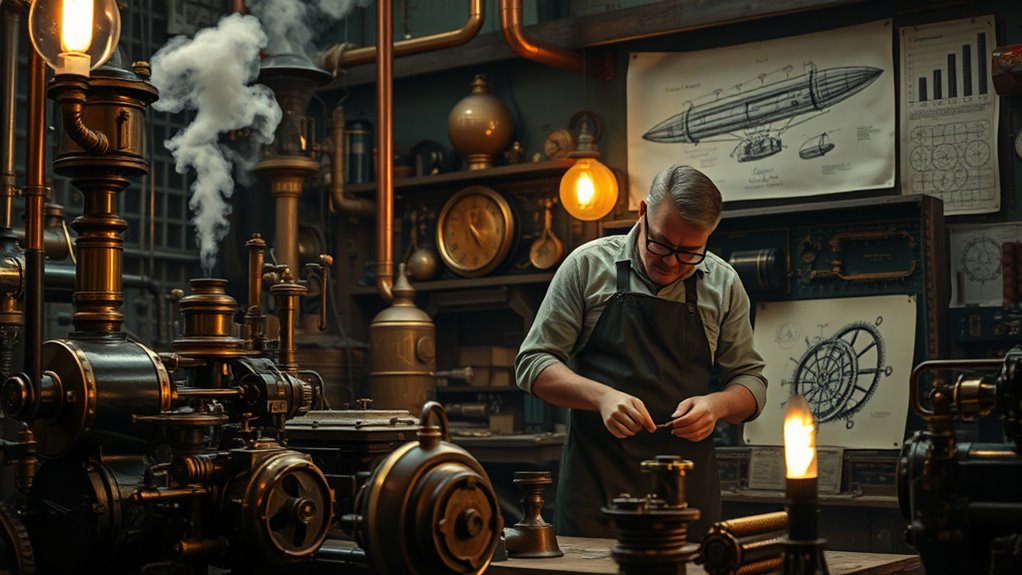
Though often romanticized, steam-powered technology serves as the backbone of steampunk’s imaginative universe. You can trace its roots back to the Industrial Revolution, where steam engines revolutionized industry and transportation. Steam locomotives were integral to the expansion of rail networks, further enhancing the movement of goods and people during this transformative era. Additionally, the high demand for fiber-rich foods in the modern world draws parallels to the innovative spirit of the steampunk genre, highlighting how advancements in one area can inspire progress in another. Emerging technologies, such as renewable energy sources, are similarly poised to drive significant changes in society. The rise of sustainability is now influencing how these advancements are perceived and integrated into new technologies. Notably, solar energy provides economic benefits through job creation and lower energy costs, showcasing how modern innovations can echo the transformative power of steam technology.
Authors like K. W. Jeter popularized the term “steampunk” in the 1980s, but the genre reflects a nostalgic vision of a Victorian era infused with fantastical inventions. In steampunk narratives, steam technology often powers everything from airships to intricate machinery, blending 19th-century aesthetics with futuristic concepts.
Key figures, such as James Watt and Richard Trevithick, laid the groundwork for this technology, enabling innovations that transformed society. Through these elements, steampunk explores themes of progress, caution, and the potential consequences of unchecked technological advancement.
Frequently Asked Questions
What Are the Main Themes Found in Steampunk Literature?
You’ll find steampunk literature brimming with themes that ignite your imagination.
It often rebels against societal norms, critiquing the class struggles of the Victorian era. As you explore deeper, you’ll encounter steam-powered machines and inventive technologies, highlighting innovation in a fantastical light.
Dystopian settings reflect darker societal aspects, while subversive narratives challenge industrialization’s impact.
Romance and adventure weave through heroic journeys, keeping you engaged in a world where the extraordinary meets the familiar.
How Does Steampunk Differ From Cyberpunk?
Steampunk and cyberpunk differ greatly in their settings and technologies.
You’ll find steampunk rooted in the Victorian era, emphasizing steam-powered machinery and historical aesthetics. In contrast, cyberpunk thrusts you into a futuristic, dystopian world filled with advanced digital tech and urban landscapes.
While steampunk celebrates retro-futurism with earthy tones, cyberpunk dazzles with neon lights and gritty visuals. Each genre offers a unique exploration of technology’s impact on society, showcasing distinct cultural influences.
Are There Steampunk Conventions or Gatherings?
Yes, there are plenty of steampunk conventions and gatherings you can attend!
Events like the Key City Steampunk Convention in Gettysburg and the Steampunk World’s Fair in New Jersey offer a variety of activities, from workshops to fashion shows.
You’ll find live performances, interactive dueling, and panels discussing literature and technology.
These conventions create a vibrant community where you can meet fellow enthusiasts and explore unique steampunk goods.
Don’t miss out!
What Role Does Fashion Play in the Steampunk Subculture?
Fashion plays a pivotal role in the steampunk subculture, serving as your canvas for self-expression.
You can blend Victorian aesthetics with industrial elements, creating unique outfits that reflect your individuality. The DIY spirit encourages customization, letting you showcase your creativity.
As you engage with the community at conventions or online, your fashion choices become a way to connect, share ideas, and celebrate the inclusive culture that steampunk embodies.
How Has Steampunk Influenced Contemporary Art and Design?
Steampunk’s influenced contemporary art and design by merging historical aesthetics with modern innovation.
You’ll see this in artwork that combines retro-futurism with exposed machinery, creating unique narratives.
In design, furniture and lighting often incorporate industrial elements, while fashion blends Victorian styles with mechanical accents.
This eclectic mix encourages a DIY culture, allowing you to repurpose materials and embrace craftsmanship, making each piece a distinctive representation of steampunk’s imaginative spirit.
Conclusion
In exploring the birth of steampunk, you’ve journeyed through a fascinating blend of history and imagination. From the creative minds who coined the term to the steam-powered gadgets whirring in the background, steampunk invites you to envision a world where the past and future collide. Picture a bustling Victorian street, where gears and gadgets coexist with the glow of neon lights. Steampunk isn’t just a genre; it’s a vibrant culture that continues to inspire and captivate.
